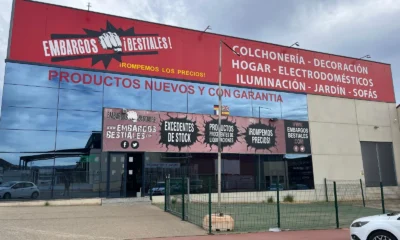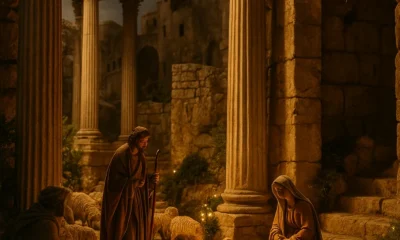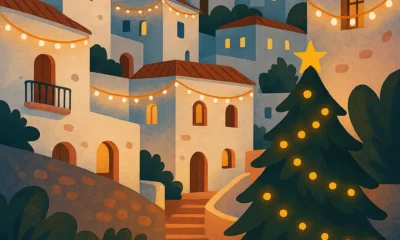Food & Drink
Roquetas de Mar gastronomy: A new European food status
Published September 26, 2025 | Category: Food & Drink
TL;DR: Roquetas de Mar is staking a claim as a European food reference. Built on centuries of salt, fish and land use, the town now combines horticultural powerhouses, fishing traditions and modern gastronomy. A recent reverse mission and the MareTerra congress put this heritage on stage, aligned with the Ciudad Gastronómica Española 2025 strategy. Here’s the full story — past, present and future.
Roquetas de Mar gastronomy: from salt pans to a European food status
Table of Contents
- 1) Historical roots: salt, fish and land
- 2) Recent drivers: mission, congress, recognition
- 3) The agri-economy of Almeria: figures and role
- 4) Gastronomic culture and traditions
- 5) Evolution of menus and culinary styles
- 6) Sustainability, innovation and challenges
- 7) Looking ahead: where Roquetas is headed
- 8) Visitor’s guide: practical tips
1) Historical roots: salt, fish and land
Roquetas de Mar’s connection to food goes back two millennia. Roman sources mention its salt pans and fish-based products such as garum, exported throughout the empire. Over the centuries, artisanal fishing remained central. By the 20th century, land use shifted dramatically with the rise of plastic-covered greenhouses — a hallmark of Almeria’s agriculture today. These layers of history explain why Roquetas gastronomy balances seafood and horticulture so naturally.
2) Recent drivers: mission, congress, recognition
In 2025 the town council, with the Almería Chamber of Commerce, launched a reverse mission bringing European food editors and chefs to see Roquetas first-hand. Chef Estefanía Marchal led showcookings showcasing fish and greenhouse produce. Immediately after came the first MareTerra (Huerta y Mar) congress in Aguadulce, a two-day public event with tastings, demos and a swordfish ronqueo. These initiatives support Roquetas’ title as Ciudad Gastronómica Española 2025, consolidating its European profile.
3) The agri-economy of Almeria: figures and role
Roquetas sits within the Poniente Almeriense, one of Europe’s most productive agricultural belts. Greenhouses here produce tomatoes, peppers, cucumbers and aubergines year-round. Exports exceed several billion euros annually, with Germany and the UK as key markets. The sector employs tens of thousands across the province and drives parallel industries: packaging, logistics and R&D centers like LABCOLOR. Roquetas’ gastronomy thus reflects not only local culture but also a vital European food supply chain.
4) Gastronomic culture and traditions
Culinary traditions are inseparable from community life. Annual tapas routes highlight local creativity in bite-sized dishes, while feria celebrations feature grilled sardines, paellas and communal meals. The sea’s bounty, from red mullet (salmonete) to pargo, is celebrated in beachside chiringuitos. Inland products — olive oil, almonds, honey — complement coastal flavors. Together, these create a cultural script where gastronomy is part of fiestas, rituals and identity.
5) Evolution of menus and culinary styles
Traditional staples like cuajadera (oven-baked fish with vegetables) or rice “de mar” remain anchors. Yet Roquetas’ younger chefs are experimenting with modern techniques: light smoking of fish, emulsions with local olive oil, or pairing greenhouse vegetables with global flavors. Gastro bars reinterpret tapas with flair, while still grounding them in provenance. Visitors can experience both ends of the spectrum: rustic fried-fish platters and Michelin-inspired tasting menus.
6) Sustainability, innovation and challenges
Almería’s greenhouses are global case studies in efficient water use and closed systems. Roquetas builds on that by pushing sustainability into hospitality. Local bars and restaurants join programs such as Hostelería #PorElClima, targeting energy savings and waste reduction. Challenges remain: balancing mass tourism with ecological footprints, adapting to climate pressures, and ensuring fair labor in agriculture. Still, transparency is high — many cooperatives welcome visitors, turning production sites into educational stops.
7) Looking ahead: where Roquetas is headed
The success of MareTerra signals that gastronomy is now central to Roquetas’ tourism strategy. Expect annual editions, stronger international press coverage, and tie-ins with sustainability networks. The town aims to extend its narrative: from “sun and beach” to “sun, beach and gastronomy.” For visitors, that means more curated experiences — from chef-led tours of the market to public ronqueo demonstrations. In the long run, Roquetas seeks to anchor itself in the European culinary map alongside cities like San Sebastián or Lyon, but with its own sea-and-greenhouse identity.
8) Visitor’s guide: practical tips
- Markets: Start at the municipal market to see produce and fish culture in action.
- Chiringuitos: Book seaside for fried fish, especially red mullet and pargo.
- Events: Time your visit with the next MareTerra congress or local tapas routes.
- Menus: Ask for cuajadera, seafood rice, or greenhouse vegetable dishes in season.
- Etiquette: Reserve early for showcookings; arrive before Spanish peak dining times for easier seating.
Not just a coastal resort
Roquetas de Mar is no longer just a coastal resort — it is a gastronomic story rooted in salt pans, fishing boats and the innovation of greenhouses. By opening its doors to experts and citizens alike, the town is redefining itself as a culinary hub. For more features and guides, explore our Towns & Villages section.
For more updates from across the province, visit Latest articles.
More on food, visit Food & Drink.
Sources
Food & Drink
Club Sabores Almeria Launches New Loyalty Programme for Local Gourmet Products
Published November 19, 2025 | Category: Food & Drink
TL;DR: Diputación de Almería has launched Club Sabores Almería, a new loyalty programme that rewards customers with discounts, gifts, exclusive tasting experiences and priority access to events. The initiative strengthens the province’s gourmet identity and supports local producers.
Club Sabores Almeria: celebrating local flavours
Sabores Almería, the official gourmet brand of the province, has launched a major new initiative: Club Sabores Almería, a loyalty programme designed to reward regular customers, promote high-quality local products and strengthen the connection between producers and the wider community. The programme represents a strategic step in the brand’s growth, offering incentives to residents and visitors who choose to support local food artisans.
The project is backed by the Diputación Provincial de Almería and closely linked to the official platform Sabores Almería, which showcases more than 120 producers from every corner of the province—from Sierra de los Filabres to Cabo de Gata, from the Almanzora Valley to the Alpujarra Almeriense. Over the past years, Sabores Almería has positioned itself as one of the most respected provincial food brands in Andalucía, gaining visibility at national and international fairs.
A brand built on authenticity and small-scale excellence
The success of Sabores Almería lies in its combination of authenticity, craftsmanship and the diversity of its members. The brand brings together cheesemakers, olive oil cooperatives, seafood specialists, artisanal bakeries, honey producers, traditional almond processors, vineyards, distilleries and family-run confectionery workshops. Each represents a piece of the province’s culinary heritage, where quality is often linked to generational knowledge and rural identity.
With the opening of the physical shop on Paseo de Almería—also connected to its online store at Sabores Almería Store—the brand has expanded its reach to a broader public, making it easier for both locals and tourists to discover high-quality products curated under a unified seal.
Exclusive benefits for club members
The new loyalty programme is designed to enhance the customer experience and encourage deeper engagement with local products. Members of Club Sabores Almería will enjoy:
- A personalised welcome gift upon signing up.
- A permanent 10% discount on all purchases in the official shop.
- Priority booking for tastings, showcooking events, and gourmet workshops.
- Weekly featured products with special offers or discounts.
- A bonus gift for purchases exceeding €50.
- Early notifications about new producers, seasonal campaigns, food fairs, and province-wide activities.
According to Diputación representatives, the idea is to “reward loyalty while reinforcing the value of local products and the people who create them”—a message aligned with wider provincial strategies supporting rural development and sustainable agriculture.
How to join the club
Becoming a member of Club Sabores Almería is straightforward. Customers only need to make a purchase of at least €30 at the official shop on Paseo de Almería, 34. Registration is free, and members receive their personalised card immediately. From that moment on, they gain access to all benefits.
The system is designed for accessibility. Tourists visiting Almeria city for a short stay can join the club effortlessly, and thanks to the online store, they can continue purchasing products after returning home. Meanwhile, local residents may find the programme particularly beneficial, given the increasing popularity of sourcing quality local foods directly from the province’s producers.
Strengthening food culture and rural identity
Beyond simple discounts, the loyalty programme taps into something much deeper: Almeria’s collective food identity. The province has long been shaped by agriculture, traditional crafts, fishing communities and small-scale production. Many Sabores Almería products come from rural villages where culinary traditions are closely linked to daily life and community heritage.
By promoting local products, the brand supports sustainable rural economies and gives visibility to producers who often operate with limited resources. Each purchase becomes more than a transaction—it becomes a contribution to the preservation of craft traditions and the revitalisation of areas facing depopulation or economic challenges.
A boost for gastronomic tourism
Food tourism has grown significantly in Almeria, driven by travellers seeking authentic experiences rooted in local culture. Wine routes, olive oil tastings, almond orchards, artisanal cheese workshops, traditional pastry-making sessions and guided visits to rural cooperatives have become increasingly popular. Sabores Almería plays a central role in this trend, offering structure, visibility and quality assurance.
The new loyalty programme is expected to attract even more interest from visitors who wish to engage with the province’s culinary scene. Priority access to tasting events and gourmet workshops may become a highlight for those exploring the region.
A long-term investment in local producers
Diputación de Almería emphasises that Club Sabores Almería is not just a commercial initiative—it is a long-term strategy designed to strengthen the position of local producers in a competitive market. By encouraging loyalty and increasing the visibility of lesser-known artisans, the programme supports economic diversification and contributes to sustainable growth.
For more updates from across the province, visit our Food & Drink category.
Real Estate & Economy
How the Garrucha Red Prawn Festival Boosts Tourism and the Local Economy
Published October 30, 2025 | Category: Real Estate & Economy
TL;DR: The Garrucha Red Prawn Festival 2025 attracted thousands of visitors and generated an estimated €0.4 – €1 million in local spending. Hotels filled up, restaurants stayed busy, and the town’s signature seafood — the Gambas Rojas de Garrucha — once again proved to be both a culinary and economic powerhouse for Almeria.
Table of Contents
- A Festival that Moves Money and People
- Tourism Impact: Thousands Visit Garrucha
- Local Business and Hospitality Boost
- The Value of the Gambas Rojas de Garrucha
- Extending Almeria’s Tourism Season
- Conclusion
A Festival that Moves Money and People
When Garrucha hosts its annual Red Prawn Festival, the town transforms from a quiet fishing port into a bustling showcase of gastronomy, culture, and enterprise. The 2025 edition, held from October 24 to 26, drew visitors from across Andalusia and beyond, offering proof that food festivals can be serious economic engines — not just community celebrations.
According to local organisers, the event gathered dozens of exhibitors, including restaurants, seafood producers, and members of the Sabores Almeria brand, in a weekend dedicated to Almeria’s most prized crustacean: the Gambas Rojas de Garrucha.
Tourism Impact: Thousands Visit Garrucha
Media reports describe “thousands of visitors” crowding Garrucha’s port throughout the weekend — a reasonable estimate places attendance between 8,000 and 12,000 people. With most tapas dishes priced at €3.50 and visitors typically consuming multiple servings plus drinks, direct food-and-beverage turnover likely reached €120,000 – €300,000.
Beyond the festival grounds, the influx created a noticeable shoulder-season tourism boost. October is usually a calmer month after the busy summer, but during the festival weekend local hotels reported near-full occupancy. Based on comparable events and data from Spain’s Instituto Nacional de Estadística (INE), Garrucha and nearby coastal towns such as Vera Playa and Mojácar likely recorded 800 – 1,800 room nights, representing €68,000 – €189,000 in hotel revenue.
Local Business and Hospitality Boost
Restaurants and bars around the harbour benefitted from the extra footfall, with owners reporting turnover increases of 30 – 50 % compared to an average autumn weekend. The festival also brought indirect spending in shops, petrol stations, and taxi services — estimated at €200,000 – €480,000 across the municipality.
Mayor Pedro Zamora summed it up during the opening ceremony:
“This festival unites residents, businesses, and visitors around our most emblematic product. The Garrucha Red Prawn represents pride, identity, and the future.”
Provincial Deputy Esther Álvarez added:
“Each edition reaffirms an idea we all share: the Gamba Roja de Garrucha is not only an exquisite delicacy but an ambassador of our land.”
The Value of the Gambas Rojas de Garrucha
The town’s fish auction — la lonja de Garrucha — depends heavily on this single species, which accounts for roughly 70 % of its annual sales value. In 2022 the lonja sold more than 34 tonnes of red prawns worth about €1.57 million, averaging €45 per kilo. During the festival itself, an estimated 1.3 – 1.5 tonnes of red prawns were consumed, representing about €60,000 – €70,000 in raw product value before preparation and retail margins.
Even in global markets, the Gambas Rojas de Garrucha are renowned for their deep red hue and sweet flavour — qualities that fetch premium prices of up to €170 per kilo at auction. For local fishermen and chefs alike, the prawn is both livelihood and legacy.
Extending Almeria’s Tourism Season
The Diputación de Almería (provincial government) promotes the festival as part of a broader strategy to extend tourism beyond the summer months. By attracting domestic visitors in late October, events like Garrucha’s festival sustain jobs and maintain hotel and restaurant operations during what would otherwise be a low-demand period.
According to the provincial tourism blog, Garrucha “volverá a ser la capital de la gamba roja” — once again the capital of the red prawn — emphasising how gastronomy, identity, and economic growth come together in one event.
Economic activity
The 2025 Garrucha Red Prawn Festival generated an estimated €388,000 – €969,000 in combined economic activity for the town and surrounding area. It demonstrated how culinary identity can translate into real financial value — sustaining small businesses, filling hotel rooms, and reinforcing Almeria’s reputation as both a coastal paradise and a land of first-class cuisine.
Methodology & Sources
Economic estimates are based on publicly available data and conservative assumptions. Visitor numbers (“thousands”) and exhibitor counts were reported by the Diputación de Almería. Hotel occupancy and average daily rate (ADR) references come from the Instituto Nacional de Estadística (INE) and Dataestur. Average spending per visitor is derived from SEGITTUR and Andalucía Lab tourism reports. Red prawn value estimates use figures from the Garrucha fish market (Lonja) and 2022 sales data published by local media.
All monetary ranges are conservative and meant to illustrate the festival’s approximate impact rather than provide audited financial results.
Discover more about Almeria’s seafood scene in our Food & Drink section.
For more updates from across the province, visit our Real Estate & Economy category.
Food & Drink
Almeria province events 2025 – Top festivals and fiestas in October & November
Published October 22, 2025 | Category: Events
TL;DR: Almeria Province celebrates autumn with a season of flavour and rhythm — seafood festivals, wine fairs, and traditional fiestas across its towns and coast.
What’s On Across Almeria Province – October & November 2025
Autumn in Almeria Province brings a burst of life to its towns and coastal communities. With cooler days and golden sunsets, October and November are filled with fiestas celebrating food, culture, and Andalusian tradition. From the coast of Garrucha to the inland hills of Huércal-Overa, here’s your guide to the most exciting local events happening this season.
🦐 VI Red Prawn Festival of Garrucha (October 24–26)
The undisputed highlight of the month is the VI Festival Gastronómico de la Gamba Roja de Garrucha, celebrating the region’s famous red prawns. Along the Paseo Marítimo in Garrucha, visitors can enjoy seafood tapas for just €3.50, live cooking shows, music performances, and children’s workshops. The festival promotes sustainable fishing and local gastronomy — making it one of the most authentic coastal experiences in Almeria Province.
The event is part of the Sabores Almeria initiative by the Diputación Provincial de Almeria, designed to highlight local producers and culinary talent. If you’re exploring the coast, this festival alone is worth a weekend visit. For official schedules, check the provincial tourism website.
🍔 The Burger Cup (ongoing through October)
In nearby El Ejido, the Burger Cup continues to attract food lovers with creative burgers crafted by local chefs. The event, hosted at the Torrecárdenas Shopping Center, mixes competition, live DJ sets, and tastings of Almeria-sourced ingredients. Visitors can vote for their favourite burger and enjoy craft beer pairings in a relaxed, social atmosphere.
🚗 Huércal Motor 2025 – Engines and Adventure
Though officially held earlier in October, the buzz around Huércal Motor 2025 continues. This motorsport and adventure fair in Huércal-Overa showcases off-road vehicles, desert tours, and motorcycle culture — a nod to Almeria’s unique landscapes that often double as film sets. Expect ongoing exhibitions and aftershows throughout the month.
🍷 Feria del Vino y Queso de Almeria (November 7–9)
Back in the provincial capital, this three-day fair celebrates wine and cheese from across Almeria. Visitors can sample local vintages from the Almanzora Valley, try artisanal goat cheese, and enjoy live flamenco performances in Plaza de la Constitución. Entry is affordable and includes multiple tastings — perfect for a relaxed afternoon of local flavours.
🎉 Fiestas Patronales de San Diego (Cuevas del Almanzora, November 2025)
Every November, Cuevas del Almanzora comes alive with its Fiestas Patronales de San Diego, one of the most traditional celebrations in northern Almeria. Expect parades, concerts, local gastronomy, and a massive paella concurso (cooking contest) where everyone is invited to taste the results. It’s a family-friendly event full of Andalusian colour and music, ideal for visitors seeking a genuine village fiesta.
🥘 Degustho Festival Gastronomico (Huércal-Overa – Preview 2026)
Although officially returning in April 2026, the Degustho Festival already has food lovers talking. This popular fair in Huércal-Overa celebrates regional cuisine, with a focus on traditional recipes, olive oils, and the famous tortilla concurso (omelette competition). Many local chefs are teasing early tastings and pop-up demos this autumn — a preview of what’s to come.
🎃 Halloween & Autumn Markets
Across the province, Halloween weekend adds a creative twist to local markets and bars. From Vera Playa to Roquetas de Mar, expect themed tapas, live DJs, and pumpkin-decorating workshops for children. Some towns also host small autumn fairs, offering handmade crafts and seasonal produce like almonds, chestnuts, and pomegranates.
🌅 Explore Almeria Beyond the City
One of the best parts of Almeria Province in autumn is the variety of experiences within an hour’s drive. Spend a morning at a coastal festival, then head inland to explore Serón, Laroya, or the Sierra de los Filabres. With mild temperatures and quiet roads, October and November are ideal for discovering Almeria’s villages, vineyards, and mountains.
Check the official calendar via the Diputación de Almeria website for regional schedules and travel updates.
For more stories about life in the province, visit our Towns & Villages category.
Almeria News
Red Prawn Festival Garrucha 2025 Confirmed | Programme, Dates & Events
Published October 23, 2025 | Category: News · Events
TL;DR: The sixth edition of the Red Prawn Festival Garrucha 2025 takes place this weekend, from October 24–26, featuring €3.50 tapas, live music, and the best of Almeria’s seafood culture.
Garrucha Confirms Full Programme for the 2025 Red Prawn Festival
It’s official — Garrucha’s Red Prawn Festival 2025 returns this weekend for three days of food, music, and celebration. From Friday, October 24 to Sunday, October 26, the popular coastal town will once again pay tribute to its most famous delicacy, the Gamba Roja de Garrucha, a deep-red prawn that has become a hallmark of Almeria’s gastronomy.
The festival, now in its sixth edition, will feature affordable tapas tastings at €3.50 (drinks not included), prepared by local restaurants and seafood producers. Each day will include live performances, a children’s activity area, and a variety of events along the seafront promenade.
Three Days of Taste and Tradition
The celebrations begin Friday at noon with the official opening ceremony and a concert by The Freedom Band. On Saturday, stands open at 1:00 p.m. and continue until midnight, with a performance by Los Lagartos in the evening. Sunday marks the festival’s grand finale — a traditional tasting of Red Prawn tapas followed by music from Elegante y Embustero.
Mayor Pedro Zamora highlighted the event as “a source of pride that reflects the town’s maritime roots, artisanal fishing, and commitment to quality.” The festival is organised by the Town Hall of Garrucha, with support from the Provincial Council of Almeria and the Junta de Andalucía.
Celebrating Almeria’s Culinary Heritage
The Gamba Roja — caught in the deep, clean waters off Garrucha — is recognised as one of Spain’s finest seafood products. Its natural sweetness and bright colour make it a favourite among chefs and diners alike. The annual festival not only boosts tourism but also honours the fishing families who keep this tradition alive.
For the full background and cultural context behind the Gamba Roja de Garrucha, read our feature: Almeria’s Red Prawn Celebration.
For more updates from across the province, visit our Food & Drink category.
-

 Infrastructure6 days ago
Infrastructure6 days agoMurcia–Almería High-Speed Rail: €9.6 Million in New Funding
-

 Events6 days ago
Events6 days agoMojácar Christmas 2025: Disney Day & Official Lights Switch-On
-

 Events5 days ago
Events5 days agoTerreros Slalom 2025: 35 Drivers Compete in a Key Andalusian Championship Round
-

 Community5 days ago
Community5 days agoDisney in Almeria: The Forgotten Story of the Park That Almost Happened
-

 Expats & Living6 days ago
Expats & Living6 days agoEmbargos Bestiales Antas – Affordable Furniture and Home Goods in Almería
-

 Towns & Villages1 day ago
Towns & Villages1 day agoVera Nativity Scene 2025: A Monumental Journey to Ancient Rome















